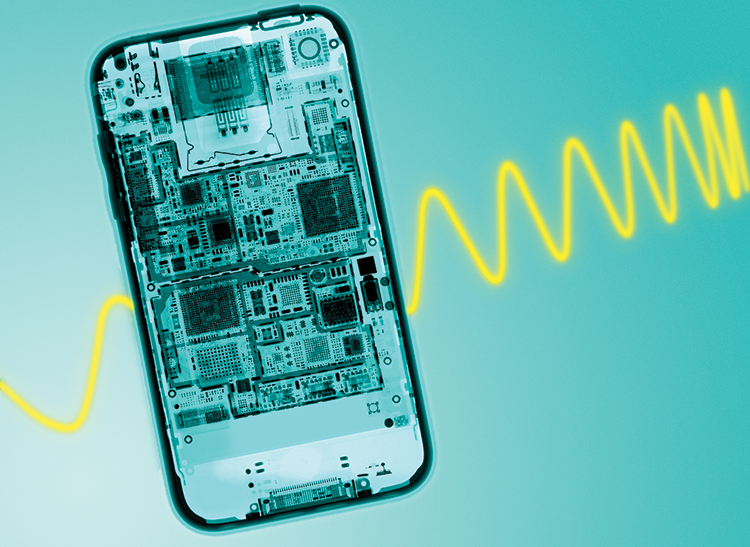[Dati epidemiologici resi noti di recente indicano un drammatico aumento dell’incidenza di disturbi dello spettro autistico.
In precedenza l’incidenza di autismo riportata era di 4-5 casi ogni 10.000 bambini, mentre le evidenze più recenti indicano un incremento fino a circa 1 caso ogni 500 bambini.
Tuttavia l’eziologia dell’autismo è ancora da determinare, ma i dati recentemente resi noti suggeriscono una
possibile correlazione tra l’incidenza di autismo e una “tossina” ambientale precedentemente non considerata.
Nello specifico, è comunemente accettato nella comunità scientifica che le radiazioni in radiofrequenza siano un elemento biologicamente attivo ed è anche stato prontamente riconosciuto che l’esposizione umana alle radiazioni in radiofrequenza sia diventata pervasiva nel corso degli ultimi venti anni, mentre era rara nel periodo antecedente: questo fa dunque pensare che l’esposizione fetale o neo-natale alle radiazioni in radiofrequenza potrebbe essere associata all’incremento dell’incidenza di autismo.]
Med Hypotheses. 2004;62(2):195-7.
By:
Kane RC1.
1The Associated Bioelectromagnetics Technologists, PO Box 133, Blanchardville, WI 53516-0133, USA. rkane@tds.net
ARTICLE INFO
Article history
Received: 6 January 2003
Accepted: 15 October 2003
Published: February 2004
ABSTRACT
Recently disclosed epidemiological data indicate a dramatic increase in the incidence of autism spectrum disorders. Previously, the incidence of autism has been reported as 4-5 per 10000 children. The most recent evidence indicates an increased incidence of about 1 per 500 children. However, the etiology of autism is yet to be determined. The recently disclosed data suggest a possible correlation between autism incidence and a previously unconsidered environmental toxin. It is generally accepted in the scientific community that radiofrequency (RF) radiation is a biologically active substance. It is also readily acknowledged that human exposures to RF radiation have become pervasive during the past 20 years, whereas such exposures were uncommon prior to that time. It is suggested that fetal or neo-natal exposures to RF radiation may be associated with an increased incidence of autism.
Introduction
Prior to the twentieth century the only sources of radiofrequency (RF) radiation were the hyper-low levels of RF energy originating from our sun and the even lower levels of extra-solar RF noise. It is in this environment of low-level RF radiation that life on earth developed and exists to this day.
During the 1940s, primarily as a result of research and development performed as a part of the war effort, industry and the military establishment were successful in bringing the state of RF energy generation to maturity. From that time onward we have witnessed a broad range of commercial RF energy product applications including, most notably, broadcast FM radio, radar, television, publicservice mobile communication transceivers, residential microwave ovens, and the portable cellular telephone.
Initially, the contribution of each radiating device was imperceptible when weighed against the background of incoming solar radiation. However, over the span of decades the number of terrestrial RF radiation sources, now counted in the billions, has increased to the degree that, presently, the base radiation level is many thousands of times higher than from solar RF energy impinging on the earth.
Notwithstanding the proliferation of RF radiation sources during the early decades of the “radiofrequency age”, the 1940s through the 1970s, humans were seldom exposed to RF radiation at levels that might cause concern. Since the late 1970s a number of commercial products have become ubiquitous, which provide human exposures to levels of RF radiation that are significantly higher than either of the previous or present background levels. Research reports indicate that RF exposure levels, typically encountered from some commercial products, may induce alterations of biological processes or damage to the genome [1 – 13].
Concurrently the incidence of autism diagnoses demonstrates a pronounced, approximately linear, nearly three-fold increase occurring during the last twenty years. “The question as to when autism begins in any child remains to be answered. Some studies provide support for a prenatal or perinatal origin for autism.” [14] For several decades prior to 1980 autism incidence remained essentially invariant; reportedly at about one diagnosed case per 2005 children. Byrd has reported a present autism incidence of about one per 700 children.
RF radiation sources have become commonplace in the personal human environment from approximately 1980 to the present. Operation of an RF radiation source such as a two-way radio or a cell phone exposes the operator to levels of RF radiation shown to be biologically active. Operation of an RF radiation source also exposes others, in the near proximity, to similarly biologically active levels of electromagnetic field intensities [15].
Some of the known effects of exposure to RF radiation include cognitive impairment [16], memory deficit [17], EEG modifications [18], DNA damage [3 – 12], chromosome aberrations [6], micronucleus formation [7, 22], fetal malformation [1, 2], increased permeability of the blood-brain barrier [19, 23], altered cellular calcium efflux [20] and altered cell proliferation [21].
RF radiation exposures from residential microwave ovens are, typically, on the order of 1 milli-watt per cm2. RF radiation exposures from cell phones range from about 0.1 to 10.0 milli-watt per cm2. Portable two-way radios provide similar exposure levels. The scientific literature confirms that RF radiation exposures, at levels more than 1,000 times lower than described immediately preceding, or on the order of 1.0 micro-watt per cm2, induce significant changes in biological processes or molecular repair mechanisms [12].
During gestation the possibility of unobservable embryonic and fetal damage is increased as mothers-to-be utilize and are exposed to the emissions from RF radiation devices. Researchers have emphatically reported that an embryo or fetus should not be exposed to radiofrequency radiation such as that emitted by the portable cell phone or portable telephone. One particular reason to avoid RF radiation exposure during pregnancy is that an embryo or fetus may not be fully protected by amniotic fluid for extended periods of time due to the natural movement of the embryo or fetus within the womb. Secondly, the pelvic structure promotes deep RF radiation penetration and that radiation can be absorbed within the developing embryo or fetus.
Other researchers have postulated that there may exist a previously unidentified environmental toxin associated with the observed increased incidence of autism. For example, the works of Byrd (California – 1999) [14], Bertrand [24], (New Jersey – 2001), Taylor [25], (United Kingdom – 1999), and Chakrabarti & Fombonne [26], (United Kingdom – 2001) clearly support the proposition that the identified increased incidence of autism has an origin at about 1980: an increased incidence that has its origin established at the very time the personal RF radiation devices came into popular use – about 1980. We propose that RF radiation, a new form of exposure of the human embryo, fetus, and infant, and an acknowledged environmental toxin under many exposure conditions, may be associated with the increased incidence of autism. This proposition is further based on the fact that these radiating products are periodically and typically utilized in the embryonic, fetal and neonatal environment. RF radiation is the only known toxin, exposure to which is wholly correlated with the repeatedly documented increased incidence of autism: now reported by at least some researchers as greater than 1 per 100 newborn.
References
1. Berman E, Kinn JB, and Carter HB, Observations of mouse fetuses after irradiation with 2.45 GHz microwaves, Health Physics, 35, pp. 791-801, 1978.
2. Kaplan J, Polson P, Rebert C, Lunan K, and Gage M, Biological and behavioral effects of prenatal and postnatal exposure to 2450-MHz electromagnetic radiation in the squirrel monkey, Radio Science, 17(5S), pp. 135S-144S, 1982.
3. Sagripanti JL, and Swicord ML, DNA structural changes caused by microwave radiation, Int J Radiat Biol, 50(1), pp. 47-50, 1986.
4. Leszczynski D, Joenväärä S, Reivinen J, and Kuokka R. Non-thermal activation of the hsp27/p38MAPK stress pathway by mobile phone radiation in human endothelial cells: Molecular mechanism for cancer and blood-brain barrier-related effects, Differentiation, 70, pp. 120 – 129, 2002.
5. Sagripanti JL, Swicord ML, and Davis CC, Microwave effects on plasmid DNA, Radiation Research 110, pp. 219-231, 1987.
6. Fucic A, Garaj-Vrhovac V, Skara M, and Dimitrovic B, X-rays, microwaves and vinyl chloride monomer: their clastogenic and aneugenic activity, using the micronucleus assay on human lymphocytes, Mutat Res 282(4), pp. 265-271, 1992.
7. Maes A, Verschaeve L, Arroyo A, De Wagter C, and Vercruyssen L, In vitro cytogenetic effects of 2450 MHz waves on human peripheral blood lymphocytes, Bioelectromagnetics 14(6), pp. 495-501, 1993.
8. Sarkar S, Ali S, and Behari J, Effect of low power microwave on the mouse genome: a direct DNA analysis, Mutat Res 320, (1-2), pp. 141-147, 1994.
9. Lai H, and Singh NP, Acute low-intensity microwave exposure increases DNA single-strand breaks in rat brain cells, Bioelectromagnetics, 16(3), pp. 207-210, 1995.
10. Lai H, and Singh NP, Single- and double-strand DNA breaks in rat brain cells after acute exposure to radiofrequency electromagnetic radiation, Int J Radiat Biol, 69(4), pp. 513-521, 1996.
11. Repacholi MH, Basten A, Gebski V, Noonan D, Finnie J, and Harris AW, Lymphomas in E mu-Pim1 transgenic mice exposed to pulsed 900 MHz electromagnetic fields. Radiat Res, 147(5), pp. 631-640, 1997.
12. Phillips JL, Ivaschuk O, Ishida-Jones T, Jones RA, Campbell-Beachler M, and Haggren W, DNA damage in Molt-4 T-lymphoblastoid cells exposed to cellular telephone radiofrequency fields in vitro, Bioelectrochemistry and Bioenergetics, 45, pp. 103-110, 1998.
13. Hardell L, Hansson Mild K, Pahlson A, Hallquist A, Ionizing radiation, cellular telephones and the risk of brain tumours. Europ J Cancer Prevent 10, pp. 523-529, 2001.
14. Byrd RS, Sigman M. Bono M, et al, Report to the legislature on the principal findings from the epidemiology of autism in California: a comprehensive pilot study, M.I.N.D. Institute, University of California, Davis, 2002
15. Bawin SM, Kaczmarek LK, and Adey WR, Effects of modulated VHF fields on the central nervous system, Ann NY Acad. Sci, 247, pp. 74-81, 1975.
16. Chiang H, Yao GD, Fang QS, Wang KQ, Lu DZ, Zhou YK, Health effects of environmental electromagnetic fields. J. Bioelectricity 8:127-131, 1989.
17. Lai H, Horita A, and Guy AW, Microwave irradiation affects radial-arm maze performance in the rat, Bioelectromagnetics 15(2), pp. 95-104, 1994.
18. von Klitzing L, Low-frequency pulsed electromagnetic fields influence EEG of man, Phys. Medica, 11, pp. 77-80, 1995.
19. Salford LG, Brun A, Sturesson K, Eberhardt JL, and Persson BR, Permeability of the blood-brain radiation on cytolytic T lymphocytes, FASEB J , 10(8), pp. 913-919, 1996.
20. Paul Raj R, Behari J, and Rao AR, Effect of amplitude modulated RF radiation on calcium ion efflux and ODC activity in chronically exposed rat brain, Indian J Biochem Biophys, 36(5), pp. 337-340, 1999.
21. Cleary SF, Du Z, Cao G, Liu LM, and McCrady C, Effect of isothermal radiofrequency barrier induced by 915 MHz electromagnetic radiation, continuous wave and modulated at 8, 16, 50, and 200 Hz. Microsc Res Tech, 27(6), pp. 535-542, 1994.
22. d’Ambrosio G, Massa R, Scarfi MR, and Zeni O, Cytogenetic damage in human lymphocytes following GMSK phase modulated microwave exposure. Bioelectromagnetics, 23, pp. 7-13, 2002.
23. Persson BR, Salford LG, and Brun A, Blood-brain barrier permeability in rats exposed to electromagnetic fields used in wireless communication, Wireless Network 3, pp. 455-461, 1997.
24. Bertrand J, Mars A, Boyle C, Bove F, Yeargin-Allsopp M, Decoufle P., Prevalence of Autism in a United States Population: The Brick Township, New Jersey Investigation, Pediatrics, 108 (5), pp. 1155-1161, Nov. 2001.
25. Taylor B, Miller E, Farringdon et al, MMR Vaccine and Autism: No Epidemiological Evidence for a Causal Association, Lancet, 353, pp. 2026-2029, 1999.
26. Chakrabarti S, & Fombonne E, Pervasive Developmental Disorders in Preschool Children, JAMA, 285 (24), 2001.
http://www.latitudes.org/articles/electrical_sensitivity_articles.html#A%20Possible%20Association
Fonti:
http://www.ncbi.nlm.nih.gov/pubmed/14962625
http://www.medical-hypotheses.com/article/S0306-9877(03)00309-8/abstract
http://www.spiritofhealthkc.com/wp/wp-content/uploads/2014/03/PREGNANCY15-The-Link-Between-Wireless-Technology-and-Autis.pdf




